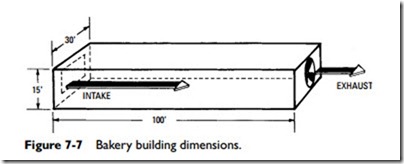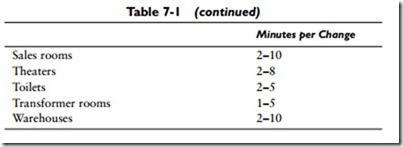Determining CFM by the Air-Change Method
In order to determine the required cfm for a structure of space by the air-change method, the following data are necessary:
1. The total cubic feet of air space in the structure or space.
2. The required number of air changes necessary to give satisfactory ventilation.
The total cubic feet of air space is easily determined by multiplying the dimensions of the structure of space. For example, a room 12 feet long and 10 feet wide with an 8-foot ceiling would have 960 cubic feet of air space (12 ft X 10 ft X 8 ft = 960 ft3).
The required number of air changes necessary to give satisfactory ventilation will depend on a variety of factors, including (1) use, (2) number of people, (3) geographic location, and (4) height of ceiling.
Usually local health department codes will specify the required number of air changes for various installations. When there are no code requirements, the data given in Table 7-1 are recommended.
Once the necessary data have been obtained, the following for- mula can be used to determine the cfm:
Let’s use the space shown in Figure 7-7 to illustrate how the air- change method is used to determine cfm. First, let’s assume that the space is being used as a bakery. In Table 7-1 you will note that a 2- to 3-minute air-change range is recommended for a bakery. The fact that a range is given is important because the number selected for the air-change method will depend on several variables. For example, a
higher number is used when the structure or space is located in a warm climate, when the ceiling is a particularly low one, or when there are a large number of people using a relatively small space. Comfort cooling, on the other hand, may be obtained by using the lowest figure in each stated range.
For the sake of our example, let’s assume that the bakery has not been designed for comfort cooling. Furthermore, the ceilings are higher than average (15 feet), and the structure is located in a warm climate. With this information, the cfm can be determined in the following manner:
Thus, 15,000 cfm are required to change the air in the bakery every 3 minutes. Assuming a 300 fpm intake velocity, 50 square feet of free air intake are needed.




